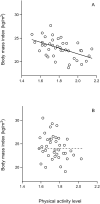Physically active lifestyle does not decrease the risk of fattening
- PMID: 19270740
- PMCID: PMC2649442
- DOI: 10.1371/journal.pone.0004745
Physically active lifestyle does not decrease the risk of fattening
Abstract
Background: Increasing age is associated with declining physical activity and a gain in fat mass. The objective was to observe the consequence of the age-associated reduction in physical activity for the maintenance of energy balance as reflected in the fat store of the body.
Methodology/principal findings: Young adults were observed over an average time interval of more than 10 years. Physical activity was measured over two-week periods with doubly labeled water and doubly labeled water validated triaxial accelerometers, and body fat gain was measured with isotope dilution. There was a significant association between the change in physical activity and the change in body fat, where a high initial activity level was predictive for a higher fat gain.
Conclusion/significance: The change from a physically active to a more sedentary routine does not induce an equivalent reduction of energy intake and requires cognitive restriction to maintain energy balance.
Conflict of interest statement
Figures


References
-
- Westerterp KR, Plasqui G. Physical activity and human energy expenditure. Curr Opin Clin Nutr Metab Care. 2004;7:607–613. - PubMed
-
- Speakman JR. Doubly-labelled water: theory and practice. London: Chapman & Hall; 1997. p. 399.
-
- Plasqui G, Joosen AMCP, Kester AD, Goris AHC, Westerterp KR. Measuring free-living energy expenditure and physical activity with tri-axial accelerometry. Obes Res. 2005;13:1363–1369. - PubMed
-
- Westerterp KR, Speakman JR. Physical activity energy expenditure has not declined since the 1980s and matches energy expenditures of wild mammals. Int J Obes. 2008;32:1256–1263. - PubMed
-
- Stubbs RJ, Hughes DA, Johnstone AM, Horgan GW, King N. A decrease in physical activity affects appetite, energy, and nutrient balance in lean men feeding ad libitum. Am J Clin Nutr. 2004;79:62–69. - PubMed

